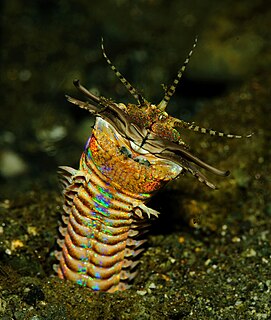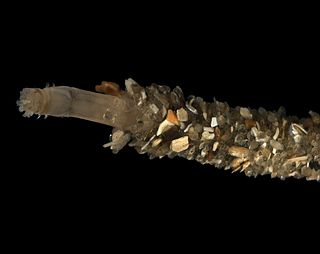
Oligochaeta is a subclass of animals in the phylum Annelida, which is made up of many types of aquatic and terrestrial worms, including all of the various earthworms. Specifically, oligochaetes comprise the terrestrial megadrile earthworms, and freshwater or semiterrestrial microdrile forms, including the tubificids, pot worms and ice worms (Enchytraeidae), blackworms (Lumbriculidae) and several interstitial marine worms.
The term parapodium refers to two different organs. In annelids, parapodia are paired, un-jointed lateral outgrowths that bear the chaetae. In several groups of sea snails and sea slugs, 'parapodium' refers to lateral fleshy protrusions.
A chaeta or cheta is a chitinous bristle or seta found in insects, arthropods or annelid worms, although the term is also frequently used to describe similar structures in other invertebrates. The plural form is chaetae or chetae.

Sabellidae, or feather duster worms, are a family of marine polychaete tube worms characterized by protruding feathery branchiae. Sabellids build tubes out of a tough, parchment-like exudate, strengthened with sand and bits of shell. Unlike the other sabellids, the genus Glomerula secretes a tube of calcium carbonate instead. Sabellidae can be found in subtidal habitats around the world. Their oldest fossils are known from the Early Jurassic.

Eunicida is an order of polychaete worms.

Phyllodocida is an order of polychaete worms in the subclass Aciculata. These worms are mostly marine though some are found in brackish water. Most are active benthic creatures, moving over the surface or burrowing in sediments, or living in cracks and crevices in bedrock. A few construct tubes in which they live and some are pelagic, swimming through the water column. There are estimated to be about 3,500 species in the order.

Oweniidae is a family of marine polychaete worms in the suborder Sabellida. The worms live in tubes made of sand and are selective filter feeders, detritivores and grazers.

Spionida is an order of marine polychaete worms in the subclass Canalipalpata. Spionids are cosmopolitan and live in soft substrates in the littoral or neritic zones.
Prosphaerosyllis battiri is a species belonging to the phylum Annelida, a group known as the segmented worms. The species name comes from an Aboriginal word, battiri, meaning "rough". Prosphaerosyllis battiri is a species characterized by having only partially fused palps, an unretracted prostomium on its peristomium or showing only slight retraction, the shape of its dorsal cirri and its arrangement of papillae, being numerous anteriorly while less numerous posteriorly. It resembles Prosphaerosyllis semiverrucosa, but its arrangement of dorsal papillae is reversed.
Salvatoria pilkena is a species belonging to the phylum Annelida, a group known as the segmented worms. The species name comes from an Aboriginal word, pilkena, meaning "different", due to its characteristic features. Salvatoria pilkena belongs to a reduced group of species that possess rugose dorsal cirri, contrary to the typical spindle-shaped cirri found in its genus. It also lacks dorsal cirri on chaetiger 2. It resembles Salvatoria swedmarki and S. celiae, differing from pilkena in that the latter has significantly longer proventricles, while its compound chaetae are short and unidentate. At the same time, S. opisthodentata has a similar body and compound chaetae but appears to possess dorsal cirri on its chaetiger 2.
Salvatoria koorineclavata is a species belonging to the phylum Annelida, a group known as the segmented worms. A related species in Australia has been described as Brania clavata and subsequently as Salvatoria clavata. While similar, the Australian species has a longer pharynx and proventricle; at the same time, blades of chaetae are present in the Australian species, with longer and upwards curved spines, which are straight in S. clavata; its pharyngeal tooth is located more anteriorly than in S. clavata. Other global species, like those in the genus Brania, are also similar to S. koorineclavata. Salvatoria californiensis has similar chaetae, with shorter spines and less developed teeth. Its acicula lacks a defined acute tip, and the proventricle is quite shorter, running through 5 segments in S. koorineclavata, with fewer rows of muscle cells. The species name comes from an Aboriginal word, Koorine, meaning "daughter", due to the similarity of the Australian species to the European species of S. clavata.
Erinaceusyllis hartmannschroederae is a species belonging to the phylum Annelida, a group known as the segmented worms. This species was previously described in Australia as Sphaerosyllis erinaceus and S. erinaceus erinaceus, a species distributed throughout the globe. These species appear to be a species complex. Previous descriptions stated that the two aforementioned species possess compound chaetae blades which are long and slender. Several subspecies of S. erinaceus were described on the basis of differences in shapes and sizes of their compound chaetae; such differences are enough to consider them as distinct species. The species is named in honour of Gesa Hartmann-Schröder, an expert on syllid species.
Sphaerosyllis bardukaciculata is a species belonging to the phylum Annelida, a group known as the segmented worms. Sphaerosyllis bardukaciculatan is similar to Sphaerosyllis aciculata from Florida; its chaetae are almost identical; the former, however, differs by having longer antennae and anal cirri, as well as parapodial glands with granular material. The animal's name is derived from the Aboriginal word barduk, meaning "near", alluding to the aforementioned likeness with S. aciculata.
Sphaerosyllis voluntariorum is a species belonging to the phylum Annelida, a group known as the segmented worms. This species is closely related to Sphaerosyllis bifurcata, Sphaerosyllis bifurcatoides and Sphaerosyllis rotundipapillata, all endemic species to Australia, characterized by having large dorsal papillae, sometimes trilobed, and with shafts of compound chaetae distally bifid. S. voluntariorum is more densely papillated on its anterior segments and has a long subdistal spine on the ventral simple chaetae. This species' name alludes to the volunteers of the Marine Invertebrate section of The Australian Museum, who sorted specimens of syllids that led to the description of this animal.
Sphaerosyllis georgeharrisoni is a species belonging to the phylum Annelida, a group known as the segmented worms. Sphaerosyllis georgeharrisoni is distinct by its large parapodial glands with hyaline material; by its small size; short proventricle; a median antenna that is inserted posteriorly to the lateral antennae; as well as long pygidial papillae. Juveniles of S. hirsuta are very similar to this species. Sphaerosyllis pygipapillata has all of its antennae aligned, a smooth dorsum, while its pygidial papillae are longer and slender. The species' name honours George Harrison, musician who died prior to the species' describing article's publication.

Acanthobdella peledina is a species of leech in the infraclass Acanthobdellidea. It feeds on the skin and blood of freshwater fishes in the boreal regions of northern Europe, Asia and North America.

Echiurus echiurus is a species of spoon worm in the family Echiuridae. It is found in the North Atlantic Ocean and a subspecies is found in Alaska. It burrows into soft sediment and under boulders and stones in muddy places.

Poecilochaetus serpens is a species of marine polychaete worm in the family Poecilochaetidae. It is a benthic worm that burrows into soft sediment.
Sternaspidae, commonly known as mud owls, are a family of marine polychaete worms with short swollen bodies. They have a global distribution and live buried in soft sediment at depths varying from the intertidal zone to 4,400 m (14,400 ft).

Sternaspis scutata is a species of marine polychaete worm in the family Sternaspidae. It occurs in the Mediterranean Sea and the temperate northeastern Atlantic Ocean. It lives submerged in mud or other soft sediment.









